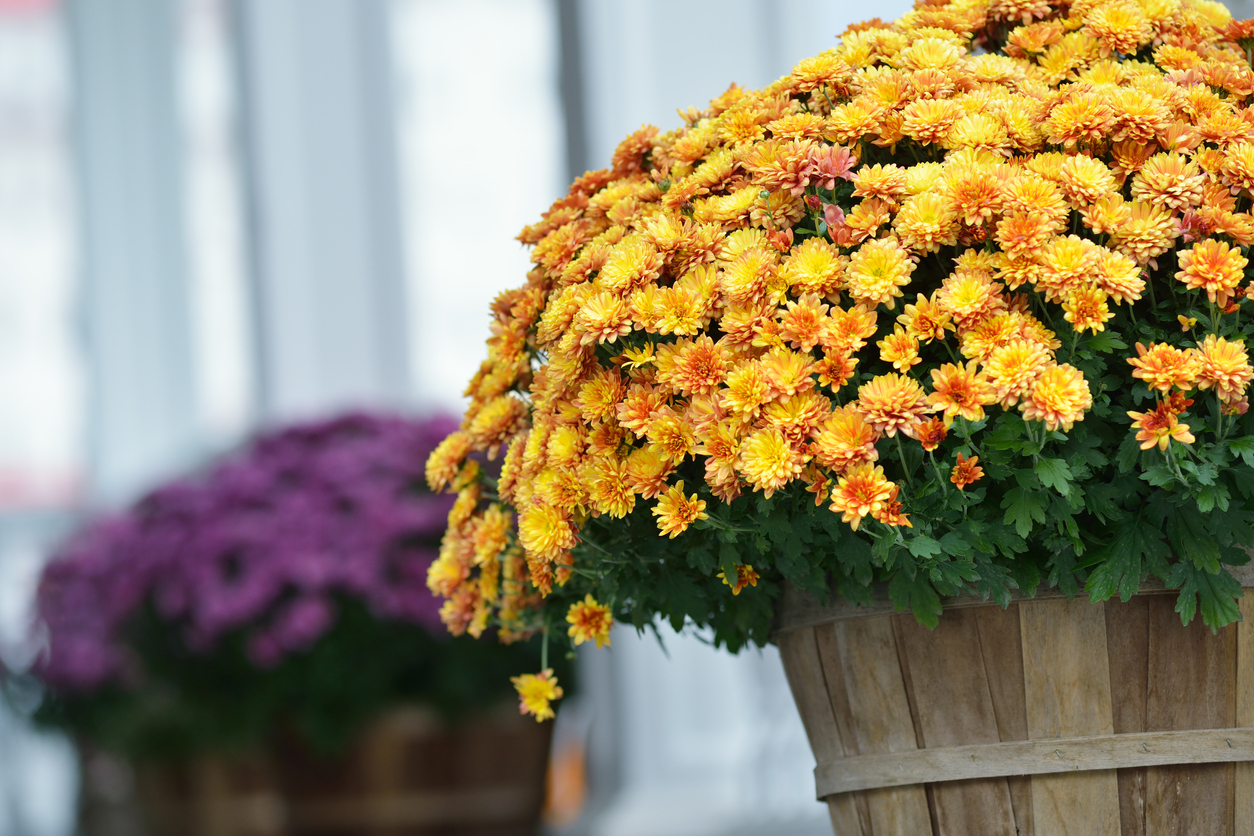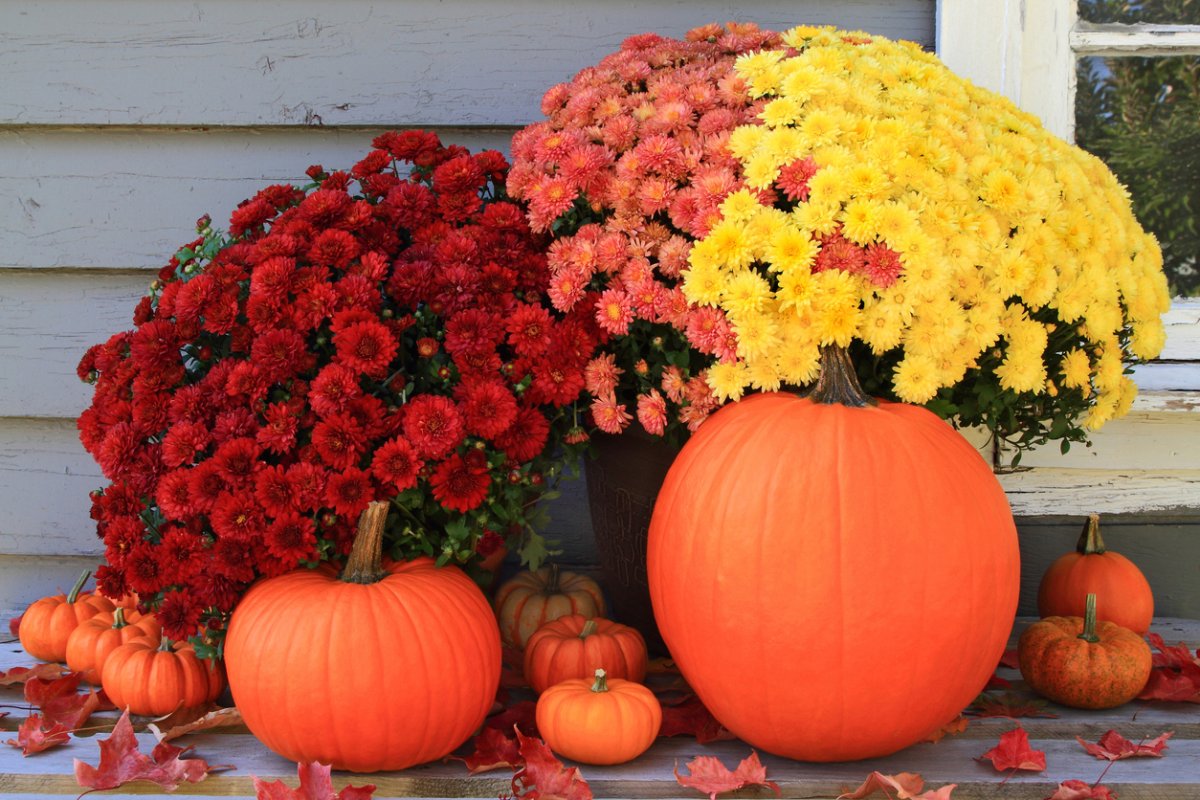We may earn revenue from the products available on this page and participate in affiliate programs. Learn More ›
Boldly colored fall mums on porches or planted in garden beds are wonderful harbingers of fall, going hand in hand with that nip in the air, the turning leaves, and the children in their back-to-school clothes.
Unlike mums found in a florist’s shop, garden mums prefer cooler temperatures and continue blooming well into fall. Buyers should be aware that while mums may be on our minds right now, this time of year is not ideal for planting. Can mums survive frost? Yes, under the right conditions.
Related: Fall Mums: How to Care for Autumn’s Hardy, Colorful Blooms
How to Care for Mums to Keep Them Blooming All Autumn Long
To maximize the blooming potential of fall mums, buy and plant them in spring, diligently pinch back growth, and deadhead spent flowers. Here are seasonal steps you can take to help your fall mums flourish all year long.
Plant Mums During the Springtime
Many people are duped into buying mums during the fall months when the colorful potted flowers show up for sale in vibrant grocery and plant store displays. But fall mums fare better when they’re planted in the spring. Early planting makes it more likely that mums, which are generally perennials in USDA hardiness zones 5 through 9, will survive the winter.
“Mums have two cycles—reproductive (flowering) and vegetative. They are vegetative when days are long and reproductive when days are short,” says Ray Gray of King’s Mums in Oregon City, OR. “We only sell our plants in the spring (March through June), when they are in their vegetative cycle. This ensures that they will be vigorously developing new roots and be in good condition to survive over the winter.”
If you want your mums to act like the perennials they are, spring planting offers better conditions. Mums planted too late in the season spend their time producing flowers and don’t expend energy growing an established root system, meaning they’re unlikely to survive harsh winter conditions.
After planting, make sure to keep the plants well watered and pinch back new shoots to encourage bushy growth. This is important because bushy fall mums produce more blossoms than leggy ones.

Be Ready for Flowers in the Fall
Mums should bloom throughout fall until a hard freeze. Deadheading spent blooms encourages new ones to flourish. Insulate mums for colder weather by spreading a couple of inches of mulch or straw over the beds, but be sure to remove or thin it in late winter, so you don’t inhibit the plant’s springtime growth.
“My understanding is that the problem with mums in the winter is being wet, not cold,” says Jan Pavlinak of Bluestone Perennials in North Madison, Ohio. Too much mulch will hold in moisture, which “blocks the plant instead of protecting it.” Pavlinak suggests going easy on mulch and making sure to leave the crown of the plant open (or very thinly covered). Too much mulch can also suffocate plant roots, which can be fatal—this is true for all plants, including fall mums.
Winterize Mums for a Spring Revival
Even if you didn’t think ahead last spring, you may still have a shot at coaxing these beauties into returning next year. First, buy mums from a nursery or independent garden center—these are also sometimes called “garden mums”— as opposed to a grocery store or florist. Look for varieties that are suited to your hardiness zone. The varieties sold in grocery stores and flower shops are usually not hardy enough to withstand winter.
Planting in the spring won’t guarantee that plants will return—especially if you live in a cold climate, but there are a few things you can do to help mums stick around:
- Avoid heavy pruning until spring.
- Mulch around the base of plants before freezing weather sets in but use only a thin layer to prevent suffocating plant roots.
- Never leave newly purchased potted mums outdoors during winter.
If you continue to have bad luck with overwintering fall mums, it may be necessary to uproot plants and overwinter them in a cold, dark space indoors.
Mums’ Sun and Water Requirements
Increase the chances of successful overwintering by making sure mums have everything they need to thrive.
Make sure to pick a spot with plenty of sun. Avoid planting mums near trees and shrubs that might obscure sunlight. Mums need plenty of water but don’t like waterlogged soil. Don’t plant them anywhere that water tends to collect since standing water can cause root rot. In dry locales, mulching around mums can help conserve moisture. When watering mums, do so from the bottom and avoid splashing leaves with water.
Mums’ Preferred Soil Type
Well-draining soil is important. Mums will not thrive in soggy soil, which will rot roots and kill the plants. When transplanting mums, add compost to the hole to increase soil fertility and consistency. Mums do best in soil with a neutral pH.

Different Types of Mums
Here are a few hardy garden mum varieties to consider for your landscape. Given that plants in Zone 5 can withstand temperatures to -20 degrees Fahrenheit (and plants in Zone 3 can survive temperatures of -40 to -30 degrees Fahrenheit), these mums’ frost tolerance is pretty high.
Debonair
This dwarf variety has pink-purple blooms that make excellent cut flowers. The plants don’t get much bigger than 20 inches tall or wide. These mums are well suited for borders, containers, and mass plantings. They are hardy to Zone 4.
Mammoth
This trademarked series of mums was created by the University of Minnesota’s mums breeding program. The hardy shrub-like plants are available in various colors, including pink, red, white, and yellow. The Mammoth series plants are perennial up to Zone 3.
Grenadine
This mum variety is known for its attractive color scheme: coral with pale yellow petals at the center. Because of their mound-like growth habit, the plants stay relatively compact and don’t grow taller than 24 inches. Grenadine mums are good for cutting and hardy to Zone 5.

How to Care for Potted Mums
Mums make excellent container plants, and the potted fall blooms look gorgeous on a front porch or balcony. When buying potted mums, pick plants that look healthy and aren’t in full bloom. At home, here’s what to do to keep potted mums happy:
- Repot your store-bought mums into a bigger container. Make sure to loosen the roots a bit and plant them in high-quality potting soil.
- Mums are thirsty plants, so make sure to water them deeply. Be sure the container has drainage to prevent root rot.
- Choose a sunny spot for the potted mums—whether that’s a sunny windowsill or front stoop is up to you.
- Fertilize monthly with a 5-10-5 fertilizer.
- Periodically check the undersides of leaves for pest activity. Mums are unlikely to become infested with pests, but insects like aphids or mites can be a problem in unhealthy plants. Spray affected plants with neem oil.
How to Care for Mums in Garden Beds
- Plant mums in spring, so they have a chance to produce strong roots.
- Make sure mums get at least 6 hours of sun per day.
- Water the flowers about an inch per week.
- Fertilize monthly with a 5-10-5 fertilizer.
- Pinch back shoots to promote bushy growth.
- Deadhead flowers when the plant is in bloom.
- Mulch around the base of plants before winter arrives, or bring plants indoors.
Final Thoughts
If all of this sounds like a lot of work or a gamble to you, there is yet another option available: Buy your fall mums where and when the mood strikes, enjoy them for the season, then say goodbye.
But there’s no harm in trying mums in the landscape. If you succeed, you’ll get plenty of bang for your buck since, with the right conditions, mums will return in springtime and live for several years.
FAQs About Fall Mum Care
Q. Do fall mums come back every year?
Yes. With proper care, fall mums can come back every year. Garden mums or hardy mums are perennials that will return under the right conditions.
Q. How long do fall mum blooms last?
Once they bloom, fall mums typically last up to three weeks. When shopping for mums, pick plants with many buds but few flowers. That way, you’ll enjoy the maximum amount of bloom time.
Q. Should mums be cut back in the fall?
The ideal time to cut back dead mum foliage is in early spring. Additionally, during fall, deadheading spent blooms encourages additional blooming.

